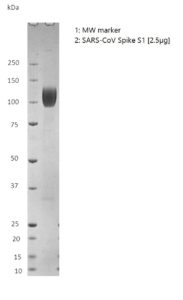SDS-PAGE: Coomassie-stained SDS-PAGE showing purified SARS-CoV Spike S1 protein.
SARS Coronavirus Spike Glycoprotein (S1), His-Tag (HEK293)
$711.87 – $2,711.88 excl. VAT
SARS Coronavirus Spike Glycoprotein (S1) is a recombinant antigen which contains amino acids 1-666 of S1 subunit. It is manufactured in mammalian HEK293 cells with
SARS CORONAVIRUS SPIKE GLYCOPROTEIN (S1)
SARS Coronavirus Spike Glycoprotein subunit 1 (S1) is a recombinant antigen manufactured in mammalian HEK293 cells, to
PRODUCT DETAILS – SARS CORONAVIRUS SPIKE GLYCOPROTEIN (S1)
- SARS Coronavirus Spike Glycoprotein (S1), amino acids 1-666 (Accession number 5WRG_A).
- Recombinant protein is manufactured in HEK293 cells with C-term His-tag.
- Purified from culture supernatant by immobilised metal affinity and ion exchange chromatography.
- Presented in DPBS, pH 7.4 at >95% purity.
- Suitable for use in ELISA and other immunoassays.
BACKGROUND
Coronaviruses are a family of large, enveloped, positive-stranded RNA viruses that cause upper respiratory, gastrointestinal and central nervous system diseases in humans and other animals (Gallagher and Buchmeier, 2001). Human coronaviruses (HCoV-OC43, HCoV-229E, HCoV-NL63 and HCoV-HKU1) circulate in humans and cause mild respiratory diseases (Su et al., 2016). However, the outbreak of SARS-CoV in 2002 and MERS-CoV in 2012 showed that coronaviruses can cross the species barrier and emerge as highly pathogenic viruses (Lu et al., 2015). The high fatality rate and wide spread of SARS-CoV and MERS-CoV confirmed that they are a severe threat to global health.
The coronavirus spike (S) glycoprotein is a class I viral fusion protein on the outer envelope of the virion that plays a critical role in viral infection by recognizing host cell receptors and mediating fusion of the viral and cellular membranes (Li, 2016). The coronavirus S glycoprotein is synthesized as a precursor protein consisting of ~1,300 amino acids that is then cleaved into an amino (N)-terminal S1 subunit (~700 amino acids) and a carboxyl (C)-terminal S2 subunit (~600 amino acids). Three S1/S2 heterodimers assemble to form a trimer spike protruding from the viral envelope. The S1 subunit contains a receptor-binding domain (RBD), while the S2 subunit contains a hydrophobic fusion peptide and two heptad repeat regions. Triggered by receptor binding, proteolytic processing and/or acidic pH in the cellular compartments, the class I viral fusion protein undergoes a transition from a metastable prefusion state to a stable postfusion state during infection, in which the receptor-binding subunit is cleaved, and the fusion subunit undergoes large-scale conformational rearrangements to expose the hydrophobic fusion peptide, induce the formation of a six-helix bundle, and bring the viral and cellular membranes close for fusion (Belouzard et al., 2012). The trimeric SARS coronavirus (SARS-CoV) S glycoprotein consisting of three S1-S2 heterodimers binds the cellular receptor angiotensin-converting enzyme 2 (ACE2) and mediates fusion of the viral and cellular membranes through a pre- to postfusion conformation transition (Song et al., 2018).
REFERENCES
- Belouzard et al. (2012). Mechanisms of coronavirus cell entry mediated by the viral spike protein. Viruses. 2012 Jun; 4(6):1011-33.
- Gallagher and Buchmeier (2001). Coronavirus spike proteins in viral entry and pathogenesis. Virology. 279(2):371-4.
- Li F. (2016). Structure, Function, and Evolution of Coronavirus Spike Proteins. Annu Rev Virol. 3(1):237-261.
- Lu et al. (2015). Bat-to-human: spike features determining ‘host jump’ of coronaviruses SARS-CoV, MERS-CoV, and beyond. Trends Microbiol. 23(8):468–78.
- Song et al. (2018). Cryo-EM structure of the SARS coronavirus spike glycoprotein in complex with its host cell receptor ACE2. PLoS Pathog. 2018 Aug; 14(8).
- Su et al. (2016). Epidemiology, Genetic Recombination, and Pathogenesis of Coronaviruses. Trends Microbiol. 2016 Jun; 24(6):490-502.


